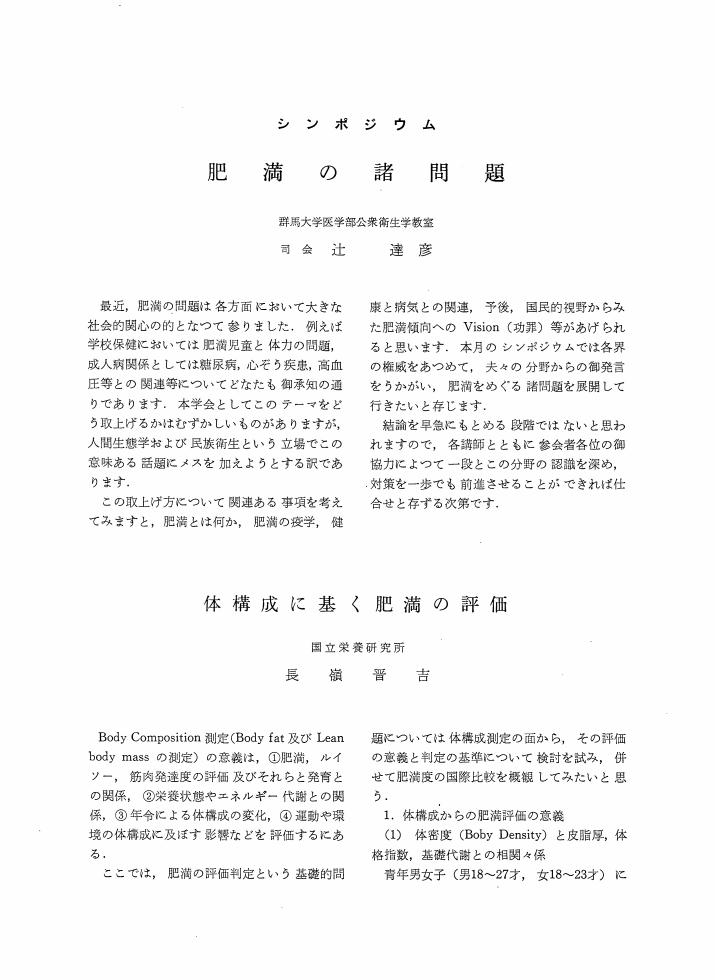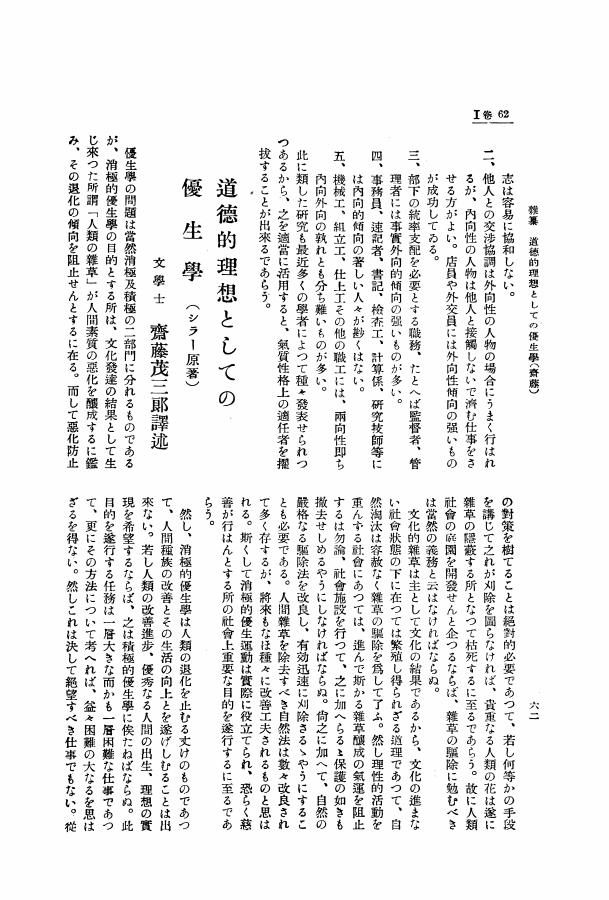1 0 0 0 OA シンポジウム
- 著者
- 日本民族衛生学会
- 出版者
- 日本民族衛生学会
- 雑誌
- 民族衛生 (ISSN:03689395)
- 巻号頁・発行日
- vol.32, no.6, pp.234-246, 1966 (Released:2010-06-28)
1 0 0 0 OA 豪雪山間地域における女性介護者の介護意思を支える経験と認識 —妻・娘・嫁の立場から—
- 著者
- 細田 きく子 纐纈 朋弥 石原 多佳子 後閑 容子
- 出版者
- 日本民族衛生学会
- 雑誌
- 民族衛生 (ISSN:03689395)
- 巻号頁・発行日
- vol.79, no.6, pp.159-178, 2013 (Released:2013-12-25)
- 参考文献数
- 21
Objectives : The experience and perception to support the intention of the female family caregivers living in the secluded heavy snowfall area who take care of their family at home and their characteristics seen in the community through analysis of the kinship type.Methods : The samples are from 7 caregivers living in A area. The research was analyzed quantity and inductively after picking up care perception.Result : From their experience, the caregivers have got perception of nursing care as follows.1, They came to the reality and love the caretakers more.2, They strengthened the family bond, hoping to spend time together and protect their family.3, They are helped by their neighbors and supporters and maintain balance between nursing care and their own life.4, Regardless of the kinship type differences, all caregivers deepened their family bond, love the caretakers and are supported by the community.Discussion : A area has established medical care service. Helped by their neighbors and supporters, the caretakers deepened the family bond and love the caretakers more.The analysis of the kinship of the caregivers shows that they have their concern as wife, daughter, or daughter-in-law, based on their family problems. The caretakers took a cognitive approach to take on nursing care.As a result, they deepened the family bond and their affection toward the caretakers through nursing care. Getting support from the professionals, they've developed their intention to continue nursing care.
1 0 0 0 OA 一般演題 抄録 第2日目
- 著者
- 日本民族衛生学会
- 出版者
- 日本民族衛生学会
- 雑誌
- 民族衛生 (ISSN:03689395)
- 巻号頁・発行日
- vol.69, no.Appendix, pp.90-145, 2003-10-31 (Released:2010-06-28)
1 0 0 0 OA 新分類法に依る拇指指紋の研究
- 著者
- 一盛 彌
- 出版者
- 日本民族衛生学会
- 雑誌
- 民族衛生 (ISSN:03689395)
- 巻号頁・発行日
- vol.14, no.3-4, pp.41-52, 1947-11-30 (Released:2010-11-19)
1 0 0 0 OA 民族術生振興の建議
1 0 0 0 OA アメリカ合衆國の断種法に就いて
1 0 0 0 OA 吾教室の血液型研究に關して
- 著者
- 淺田 一
- 出版者
- 日本民族衛生学会
- 雑誌
- 民族衛生 (ISSN:03689395)
- 巻号頁・発行日
- vol.1, no.3, pp.319-324, 1931-08-13 (Released:2010-11-19)
1 0 0 0 OA 血液型と精神現象
- 著者
- 古川 竹二
- 出版者
- 日本民族衛生学会
- 雑誌
- 民族衛生 (ISSN:03689395)
- 巻号頁・発行日
- vol.1, no.3, pp.324-340, 1931-08-13 (Released:2010-11-19)
1 0 0 0 OA 道徳的理想としての優生學 (シラー原著)
- 著者
- 齋藤 茂三郎
- 出版者
- 日本民族衛生学会
- 雑誌
- 民族衛生 (ISSN:03689395)
- 巻号頁・発行日
- vol.1, no.1, pp.62-68, 1931-03-23 (Released:2010-11-19)
1 0 0 0 フィジーにおける医療行動に関する研究
- 著者
- 泊 惇 柳橋 次雄 安藤 哲夫 脇阪 一郎 アサ ビルヒリオデ バティック フペンドラ
- 出版者
- 日本民族衛生学会
- 雑誌
- 民族衛生 (ISSN:03689395)
- 巻号頁・発行日
- vol.48, no.4, pp.189-199, 1982
- 被引用文献数
- 1
本研究はフィジー諸島における人々の医療サービスの利用状況を疾病行動の視点から分析することを目的とした。 調査はCWM病院の外来患者365名を対象とし面接調査を実施し,なお一部フィジー政府の年報を参考に分析し,以下の結果を得た。 1) 病院の利用率がフィジー人よりもインド人に高いことから,フィジー人においてはむしろ伝統的な医療への依存が高く,病院で受ける医療サービスが潜在しているものと示唆された。 2) 薬草,祈とう,治療者などの伝統医療は近代医療と同様に,該国の医療サービスにおいて近代医療の代替ではなく,重要な役割を有し健康養護の為の重要な社会資源となっているものと考えられた。
1 0 0 0 寝具―健康の視点より―
- 著者
- 多田 千代
- 出版者
- 日本民族衛生学会
- 雑誌
- 民族衛生 (ISSN:03689395)
- 巻号頁・発行日
- vol.45, no.5, pp.170-183, 1979
It is the purpose of this report to inform you the general state of the research of Japanese bed from the viewpoints of health. 1) The course of time in microclimate inside of the bed and skin temperatures distribution in sleep adequate to keep comfortable sleep were determined. 2) The weight distribution of mattresses and bedclothes which are being used at various places in Japan, were investigated. 3) Physical properties of nonhygroscopic mattresses and bedclothes which were developed one after the other owing to new techniques were tested in relation to the comfort and function in case of usage. 4) Recent research on bed has entered into a new-stage. The studies improving the recovery of functions in the brain and body during the sleep by the use of better mattress has become the central parts of interest.
1 0 0 0 アフガニスタンの衛生学的研究在留邦人の生活
- 著者
- 諏訪 久
- 出版者
- 日本民族衛生学会
- 雑誌
- 民族衛生 (ISSN:03689395)
- 巻号頁・発行日
- vol.26, no.1, pp.130-137,A9, 1960
理想的な気候, 安価で栄養の多い食物, 高給は在留邦人のもつ好条件であるが, 大部分の邦人はこれらの好条件を有効に使つて楽しむ能力がなく, 能率を下げている場合が多い. 又多くは1,2年の短期間の滞在のため, この国の事情に通じアフガン人に対しよい影響を与えるには至らない.<BR>肉体的にはこれら邦人は大部分健康であるが, 精神的には極めて不安定で精神異常を呈するものもある. 日本人は家族を伴なうべきであり, 強い意志をもち, この国に於ける生活を楽しむことが出来て, 個人の生活を互いにみだすことなく, 物事を本質的に考えることが出来る日本人を送るべきである. 英語, 独語, 仏語, ペルシヤ語等が自由に話せることは望ましく, 精神衛生上から言つても必要なる条件である.
- 著者
- 守田 則一
- 出版者
- 日本民族衛生学会
- 雑誌
- 民族衛生 (ISSN:03689395)
- 巻号頁・発行日
- vol.76, no.6, pp.235-236, 2010
1 0 0 0 OA 第25回日本民族衛生学会 特別講演
1 0 0 0 韓国における人工妊娠中絶および男子選好の出生性比に与える影響
- 著者
- 趙 南勲 洪 文植 林 謙治
- 出版者
- 日本民族衛生学会
- 雑誌
- 民族衞生 (ISSN:03689395)
- 巻号頁・発行日
- vol.62, no.5, pp.298-314, 1996-09-30
- 参考文献数
- 21
韓国における家族計画プログラムの全国的な展開により,避妊の実行が普及すると共に出生率が低下してきた.こうした初期の目標が達成された中で,人工妊娠中絶は依然に高率であり,また,出生性比も増加する傾向にある.性比の歪み伝統的な男子選好に起因するものと思われる.本論文では妊娠結果の経年的変化を調査し,人工妊娠中絶の決定要因を分析すると共に中絶と男子選好が性比の歪みどのように影響を与えているかを検討した. 人工妊娠中絶率は1980年代前半まで急激に増加しており,中絶と出生はほぼ同数であった.その後,中絶率は高い水準で推移し,出生回数が多いほど中絶率が高い傾向を示している.第1子出産後の次の妊娠結果は前子の性別により強い影響を受けることが判明した.すでに男児を得ている場合妊娠が中絶になる確率はきわめて高い.希望子供数の減少と男子選好のために既存の子供の性構成が妊娠結果を左右することにおいてより重要な因子となっている.女性の教育水準も中絶の確率に対して常に影響を与えているが,最近ではその影響度は弱まっている.婚姻外妊娠と都市化も中絶の増加の方向で影響を与えている. 本研究から得られた結果により,今後韓:国における家族計画プログラムは性比の歪みをもたらす男子選好の価値観を弱めると同時に,人工妊娠中絶を予防すべく社会政策の強化を打ち出す必要があることを示唆している.
1 0 0 0 OA 介護される権利,「ピンネンコロリ」
- 著者
- 玉城 英彦
- 出版者
- 日本民族衛生学会
- 雑誌
- 民族衛生 (ISSN:03689395)
- 巻号頁・発行日
- vol.82, no.3, pp.97-98, 2016-05-31 (Released:2016-06-22)
1 0 0 0 日本における初潮年齢の推移
- 著者
- 守山 正樹 柏崎 浩 鈴木 継美
- 出版者
- 日本民族衛生学会
- 雑誌
- 民族衛生 (ISSN:03689395)
- 巻号頁・発行日
- vol.46, no.1, pp.22-32, 1980
- 被引用文献数
- 4 4
In Japan, the decline in the age at menarche after the Second World War has been repeatedly reported, but the observed period in the reports has not been long enough to evaluate the secular trend of it. More than a hundred reports of age at menarche of Japanese have been published from the year of 1886. More than half of these populations in the reports consisted of students or young workers, some of whom had not attained menarche at the survey, and the menarcheal ages were represented by the arithmetric mean for the menarche attained girls. Thus, ages at menarche of these reports have biases toward younger menarcheal ages which depend on the proportion of non-menstruating girls. The authors aimed to correct these biased menarcheal ages on the assumption that (1) menarcheal ages of a population distributes normally when all of the girls are menstruating; (2) when some girls are not menstruating, the distribution is censored sample of normal distribution. After eliminating these biases of historical sources, the trend of the menarcheal age in Japan (from the late 19th century to the present) was analysed.
- 著者
- 平川 達
- 出版者
- 日本民族衛生学会
- 雑誌
- 民族衛生 (ISSN:03689395)
- 巻号頁・発行日
- vol.25, no.2, pp.126-132,A11, 1959
4. A survey of birth and birth-control; The average numberof birth of a woman was 3.5, which is not so high. The number of birth tended to decrease in younger generation. According to the survey on birth-control, among 48 ansewers of whom used to practice birth-control, the economical reason proved 27.1 %. Besides, it was remarkable that artificial abortion was popular
1 0 0 0 一島嶼 (伊豆七島利島) に於ける婚姻の調査研究:第5報近親結婚
- 著者
- 平川 達
- 出版者
- 日本民族衛生学会
- 雑誌
- 民族衛生 (ISSN:03689395)
- 巻号頁・発行日
- vol.25, no.2, pp.133-139,A11, 1959
5. Consanguineous marriage; The frequency of consanguineous marriage was 11.9 per cent, among which the marriage between consins were the most. The 1.62 per cent of the whole population were psychotic. This percentage is rather high comparing with other island of Izu. It was also noticed that there would be some consanguineous relations among these psychotics.<BR>Using Prof. Koike's classification, it was recognized that finger-prints were frequent in the type S and in the type OW in hand.
- 著者
- 新福 祐子
- 出版者
- 日本民族衛生学会
- 雑誌
- 民族衛生 (ISSN:03689395)
- 巻号頁・発行日
- vol.35, no.4, pp.285-293, 1969
In this report, the statistics of infant deaths are analysed and some hygienic subjects and discussed. The results obtained are as follows: 1) After the War, the peak birth rate was reached in the year 1948 with 30-40 births per 1, 000 population. In Eigenji-cho and Shigaraki-chô the rate of birth has more or less been stabilized at 12 by 1957, while in the other districts the rate still shows the tendency to a gentle decline. 2) The infant death rate, which has been calculated since 1947, decreased from 100 per 1, 000 in 1947 to 20 per 1, 000 in 1965, the last year in these data. In Kutsuki-mura this rate is slightly higher. 3) The ratio of infant deaths to the population has remarkably decreased since 1955, but it is still high in Kutsuki-mura. 4) In these districts, over 85 per cent of infant deaths were caused by pneumonia, gastroenteritis and deseases of early infancy. This percentage is somewhat higher than average. 5) The seasonal variation of infant mortality has also been observed. In Eigenji-chô and Shigaraki-chô, there is a greater concentration of deaths in the months of January, February and March. In Kutsuki-mura and Yogo-mura this is the case with the months of March and April. 6) On the months-of-age distribution of infant deaths, the percentage of neonatal deaths is always maximum and becomes larger and larger. 7) The ratio of neonatal deaths to the other infant deaths and the ratio of infant deaths to the deaths of age-group 1-4 years show that the improvement of hygiene and health services has a great influence on infants, but in Kutsuki-mura, utmost efforts must be made to decrease infant deaths.









